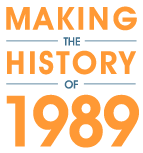Scholar Interviews
Questions
- Vladimir Tismaneanu: Is there a moment that stands out most about 1989?
- Vladimir Tismaneanu: What forces led to change in Eastern Europe?
- Padraic Kenney: Is there one moment that stands out for you personally?
- Padraic Kenney: One crucial moment of 1989?
- Maria Bucur: Is there one moment that stands out in your experience?
- Maria Bucur: What are the crucial moments of 1989?
- Maria Bucur: How did Romanians respond in the days that followed?
- Padraic Kenney: What led to the Round Table Talks?
- Gale Stokes: What do you think led to the unrest in East Germany?
- Gale Stokes: What moment stands out for you in the events of 1989?
- Gale Stokes: Why didn’t authoritarian states succeed?
- Gale Stokes: How did East Europeans react to the arrival of pluralism?
- Gale Stokes: What images of 1989 stick in your mind?
- Gale Stokes: Why did things go so badly in Yugoslavia?
Maria Bucur: Is there one moment that stands out in your experience?
Transcription
I have a hard time with saying one moment sticks in my mind more than another because I always think that it’s a combination, especially in the case of the revolutions of ’89, there’s a combination of factors that brings about this explosion, But I have to say, ultimately if I have to pick one, it’s the opening of the Hungarian border with Austria. That I think that is to me the turning point where basically you have an opening of an opportunity for people to vote with their feet and to just get out. They don’t have to express themselves inside of Eastern Europe in opposition. They just leave and so, of course, when you have, you know, hundreds of thousands of people doing that, it becomes a very important moment and movement and there’s a real effect to it. It’s not just, you know, a speech or a symbolic act. It has real effect.
